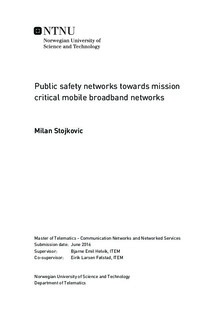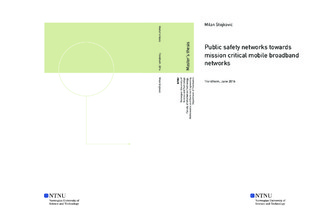| dc.description.abstract | Lack of broadband data applications in dedicated public safety networks has pushed public safety users to seek for the solutions in commercial LTE networks. However, LTE communication systems are missing functionalities like group and device-to-device communication, push-to-talk (PTT) feature, etc., which are essential for public safety users. To address those shortcomings, in the past 5 years 3GPP has been developing new functionalities for LTE that should make LTE suitable for public safety networks. Besides that, 3GPP is also working on definition of a robust LTE migration roadmap towards public safety networks solution.
This thesis 1) assesses whether new LTE functionalities match with the functionalities available in public safety communications systems today; 2) proposes security protocols for user authenticating when two new Public Safety LTE features are used; 3) evaluates different alternatives for deployment of future public safety LTE network; 4) proposes transition scenario for Norway's public safety network, i.e. roadmap for migration from TETRA to LTE network.
The assessment of the new LTE functionalities has shown that LTE will be able to provide the same communication functionalities as provided today by specialized radio communications systems for public safety networks, such as TETRA. Group Communication System Enablers for LTE (GCSE_LTE) will enable group calls in LTE, Proximity Services (ProSe) will enable device-to-device communication, Mission Critical Push To Talk (MCPTT) over LTE will provide PTT service in LTE and Isolated E-UTRAN Operation for Public Safety (IOPS) will enable LTE's base station to operate without a backhaul connection. These functionalities are expected to become available late 2017.
Analysis of security protocols proposed has shown that proposed protocols are able to meet all security requirement defined by 3GPP and establish high level of security.
Evaluation of deployment alternatives for future LTE public safety networks has shown that the choice of the right deployment model will largely depend on needs, interests and possibilities of public safety organizations. Those willing to have full control over the network and provide the most reliable services to its users will chose Dedicated LTE network model, in return they will have high costs, longer waiting time before network becomes operative and they will have to lobby for the spectrum. Public safety organizations not willing to wait long, deal with the problem of spectrum allocation and invest much will go for Commercial LTE networks model, however services they get will not be adapted to the needs of public safety users, they will have to accept that they have reduced control over the network and services and that the service availability is not high as in dedicated networks, unless network undergo upgrades, in which case each of these aspects can be improved. Third evaluated model, Hybrid solution, represents a combination of two previously mentioned models. Hybrid solution is flexible and allows public safety organizations to combine different aspects of Dedicated and Commercial LTE networks. This allows them to adapt the network to their specific needs. Exactly this feature favors this model compared to other two. However, Hybrid model can raise problems of networks interoperability and spectrum sharing, which nevertheless can be solved.
The case study has confirmed the claims on Hybrid solutions model. By using the hybrid model approach we were able to ensure seamless transition from TETRA to LTE for Norway's public safety network, Nødnett. | |

